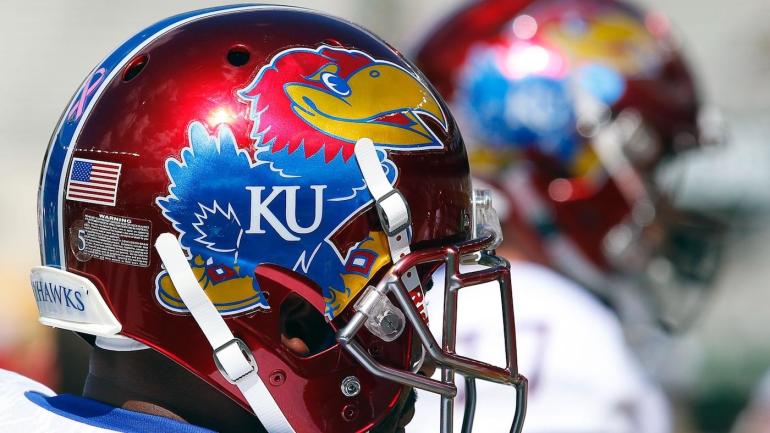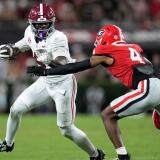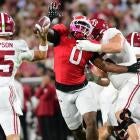Kansas strength and conditioning program will report directly to medical professionals
The Jayahwks say this shift for its strength staff is the first of its kind for a major university

University of Kansas athletic strength and conditioning personnel will now report directly to medical professionals in a move the school says is the first of its kind in the country.
The change announced Wednesday was made, in part, because of what the school said was "increased attention across college sports in recent years" regarding offseason player injuries and even death.
Offseason deaths due to exertional issues have reached a peak in college football this century. In the last two years, strength coaches were blamed after players died at Maryland and Kent State along with others who were injured at Oregon.
In all, 40 Kansas trainers, doctors and nutritionists – as well as the strength staff that previously reported to KU athletic director Jeff Long -- will now report to medical staff at The University of Kansas Health System and Lawrence Memorial Hospital Health. The new combined entity will be called Kansas Team Health.
That reporting line "minimizes potential conflict of interest between coaches and sports medicine staff," KU said in a press release.
There have been complaints for years that coaches held too much influence over athletic training, medical and strength staff.
"That's an old model," Long said. "We've been behind in college athletics, to be candid. When I got involved in athletics in the 1970s, that model was there. I think this is the next big step taking the medical piece out of it -- out of the athletic department's hands."
The difference for Kansas, the school says, is specifically incorporating strength coaches in the reporting line.
"The Kansas Team Health model of care is exceptional, providing the most transparent reporting line to assure all sports medicine and sports performance practitioners are conforming to an athlete-centered model of health care," said Brian Hainline, NCAA chief medical officer.
Hainline noted the NCAA catastrophic injury policy, which takes effect Aug. 1, establishes reporting lines that are similar to Kansas.
In 2017, the NCAA adopted as a best practice the "unchallengeable autonomous authority" of school medical officials to determine health care management and return-to-play requirements of athletes. A best practice is defined as a recommendation as being widely-held as the most effective procedure.
College athletics was rocked in May 2018 when Maryland offensive lineman Jordan McNair collapsed during a strenuous offseason workout. He died 15 days later due to complications reported to be from exertional heat stroke. The resulting investigation and scandal eventually cost the Maryland strength coach and coach DJ Durkin their jobs.
"The athletic trainers didn't cause Jordan's death," said Scott Anderson, Oklahoma's head trainer and leading student-athlete welfare advocate. "They failed to cure the exertional heat stroke the coaches caused. Until collegiate athletics has the courage to address the irrational, irrelevant 'performance enhancement-'causing morbidity and mortality, the [deaths] will continue."
In January 2017, the now-former strength coach was suspended for one month without pay after three players were hospitalized with rhabdomyolysis. The condition causes body tissues to break down due to overexertion.
A CBS Sports investigation found that Ducks' strength coach Irele Oderinde -- while certified by NCAA standards -- was certified only as a track and field strength coach. He did not have the proper training to work with football players, according to several strength and medical professionals.
Coach Willie Taggart took Oderinde to his current job at Florida State.
Later in 2017, CBS Sports reported a Kent State strength coach was fired after he falsified his certification. Under his watch, a Kent State player collapsed and died during an offseason workout.
"It's just concern," Long said of the McNair situation. "When I walked into this department, I declared my No. 1 priority is the health, safety and well-being of our student-athletes."
The Kansas initiative started with chancellor Douglas Girod, a surgeon who joined the University of Kansas Medical Center faculty in 1994.
"The norm in college athletics has been for sports medicine practitioners to report to athletics department administrators," Girod said. "We knew we had a special opportunity to be innovative and get ahead of the curve. As a result, I believe we can tell all current and future student-athletes that they're getting the best care and training in the country at the University of Kansas."
Long admitted the move lessens the school's liability. It is not uncommon when players suffer a catastrophic injury that schools, coaches and athletic departments are sued by families citing wrongful injury or death.
Earlier this month, the NCAA Board of Governors endorsed a series of recommendations to prevent catastrophic injury and death.
"Now, there's not administrative people from KU athletics or sports programs involved in those [medical accountability] decisions. They're clearly medical decisions," Long said.
Concern over the traditional injury reporting line increased in 2014 when Michigan quarterback Shane Morris was allowed to stay in a game despite clearly being impaired by a head injury. Morris was seen struggling to get to his feet and wobbled back to the huddle after a hit.
Wednesday's announcement does not keep a new Kansas coach from being able to hire his/her own strength coach and/or fire the previous strength coach, Long said.
Strength coach Andrea Hudy, Kansas' assistant athletics director for sports performance, is considered one of the best in the business. She oversees strength and conditioning for all sports at KU.
Hudy was named strength coach of the year in 2013 by the National Strength and Conditioning Association. She earned her MBA at Kansas over the weekend.


















